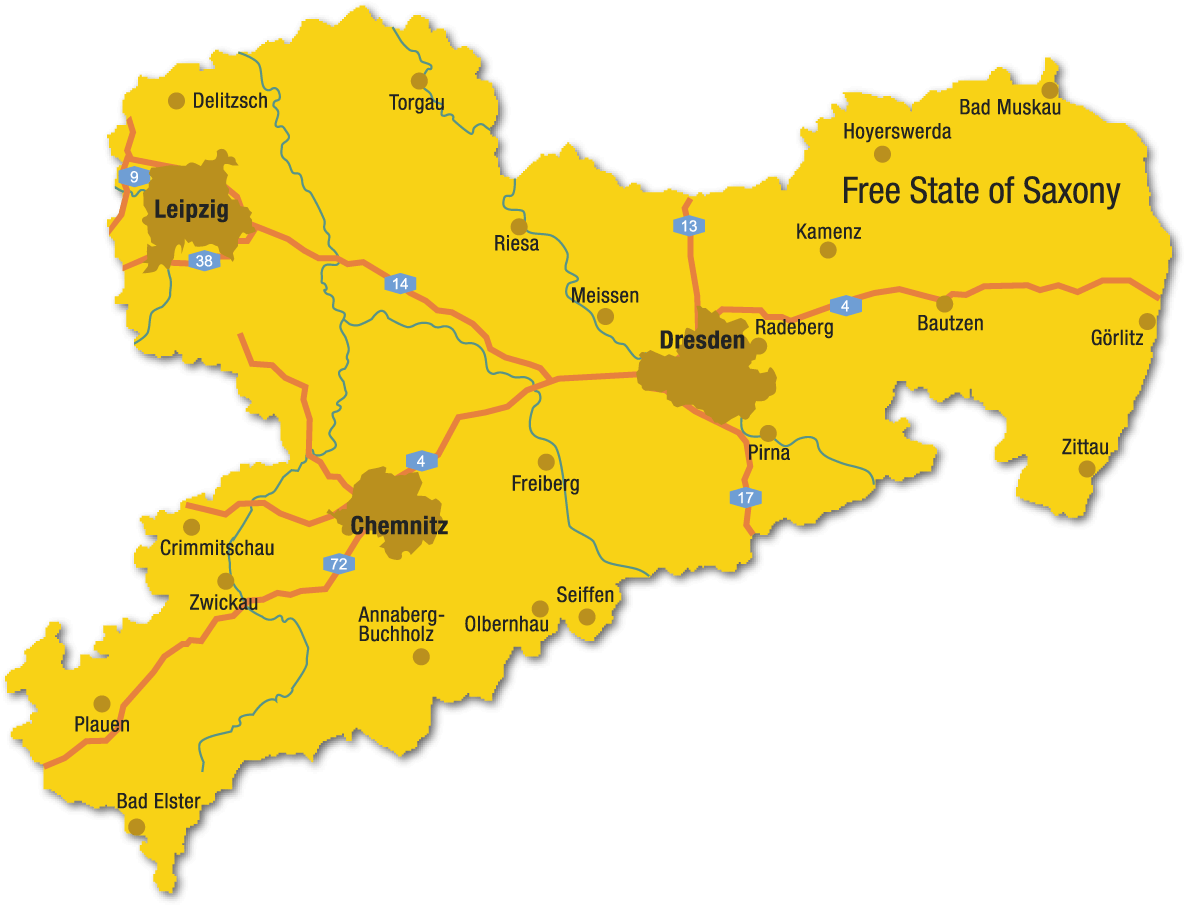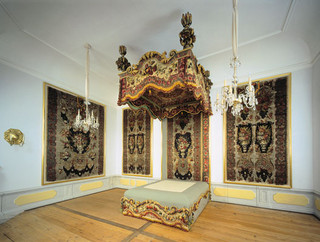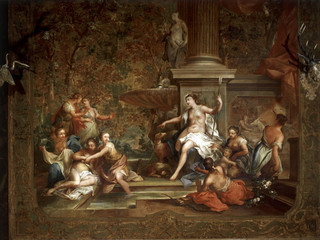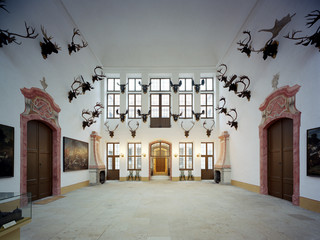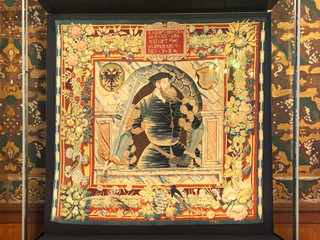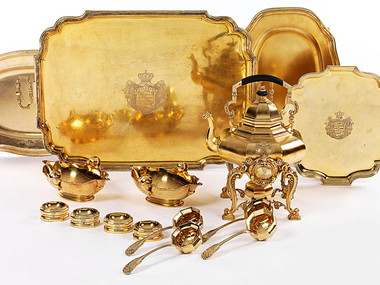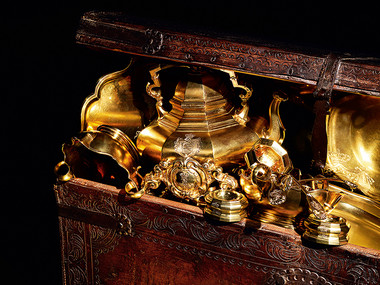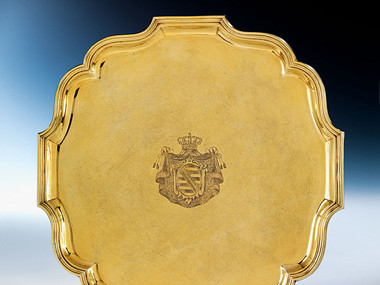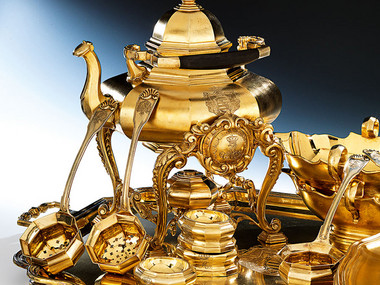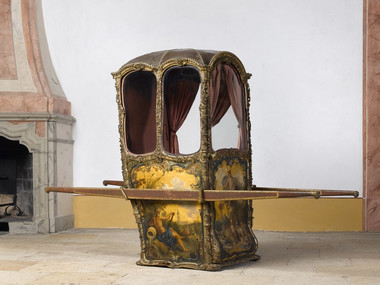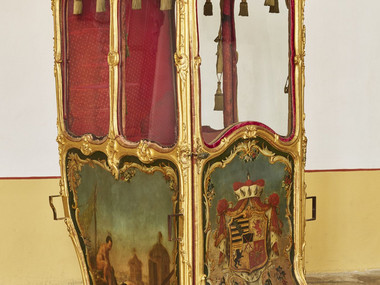Precious leather tapestries adorn the halls; The Porcelain Quarter and hunting trophies are testimony to the two passions of Elector Augustus I of Saxony – the permanent exhibition during the summer at Moritzburg Castle carries you away to the splendid backdrop of royal inmdulgences. The special highlight – apart from the Stone and Dining Hall – is the Feather Room with its unique wall decoration of feathers.
The Moritzburg Feather Room
The Feather Room is one of its kind worldwide. No wonder that there are many legends to this piece of masterly craftsmanship. So, for example, it is said to have been the throne of a Mexican king or part of Indian household equipment. And, for its manufacture, generation of American Indian slaves may have made the piece of art from millions of South-American birds’ feathers. Eventually, Augustus the Strong brought it home to Moritzburg as prize he had won in bullfighting. But how much truth is actually in all these stories?
The Leather Tapestries
Moritzburg Castle is home to the largest inventory of Baroque leather tapestries. Out of a total of 60 rooms, there are 11 rooms after all, where the leather tapestries have been preserved. The depictions are currently being restored millimeter by millimeter in a major restoration project. The depictions show scenes of Greek mythology. Diana, the Goddess of Hunting, is at the center of attention.
The Collection of Hunting Trophies
As early as in the 16th century, Moritzburg was a popular place among the Saxon ruling dynasty for excessive hunting. Hence, it hardly takes wonder that Moritzburg Castle ihas become to one of the world’s most important hunting trophy collections. Apart from the legendary 66-point red deer antlers, the uncountable number of trophies also include the antlers of an extinct giant red deer.
Tapestry with the portrait of Emperor Charles V.
The tapestry, woven from wool, silk and gold thread and measuring approximately four square metres, was completed in 1545 by the carpet weaver Seger Bombeck in Leipzig. The centre field, framed by flowers and garlands of fruit, shows a half-length portrait of the Habsburg Emperor Charles V. The tapestry was part of the furnishings of the new Dresden residential palace built in 1547 by Elector Moritz of Saxony, who owed his title of Elector to the Emperor.
From 1918 to 1945, the tapestry was kept in Moritzburg Palace. After the end of the Second World War, Prince Ernst Heinrich of Saxony took the tapestry with him as one of only a few works of art on his escape from the Red Army. His descendants moved to Canada. After being sold to Galerie Rudigier, SBG had the opportunity to acquire the tapestry and bring it back to Moritzburg Castle after years of negotiations.
In the summer of 2022, the tapestry was finally purchased thanks to a joint effort and the extremely generous support of the Kulturstiftung der Länder and the Ernst von Siemens Kunststiftung.
A forester, three princes, forty-three boxes
In January 2016, a legend returned to its fateful place: parts of the one lost Wettin treasure. They also include numerous silver pieces of tableware from the former court silver chamber.
Up close you can admire the precious pieces of the sensational find of 1996. An accompanying documentary tells the story of the legendary treasure: from its former use at court to the turmoil of war in which the treasure disappeared to its spectacular discovery, auction and return to Moritzburg. An experience that literally gilds the Moritzburg castle visit!
Moritzburg sedan chairs
The exquisitely designed royal sedan chairs were used on special occasions and were carried by two Haiducken - physically strong footmen dressed in the manner of old Hungarian soldiers - using carrying bars and shoulder straps.
The paintings on the cabin walls glorify the Saxon Elector Frederick Augustus II, as Augustus III King of Poland (reigned 1733-1763). On the lower section of the rear wall, the countries of Saxony and Poland are depicted in the form of female figures, while the Elbe and Vistula rivers are personified on the two side walls. Ancient mythological deities, such as Minerva, patron saint of war and protector of crafts, and Mercury, patron saint of peace and luck, complete the artistic design.
The four continents known at the time - Europe, Asia, Africa and America - are depicted personified with typical attributes on the side and back walls of the palanquin without supporting bars. The front shows the coat of arms of Elector Friedrich Christian of Saxony (reigned October-December 1763).
Contact
Moritzburg Castle
Schloßallee | 01468 Moritzburg
Property of State Palaces, Castles and Gardens of Saxony, non profit
+49 (0) 35207 873-18
moritzburg@schloesserland-sachsen.de
